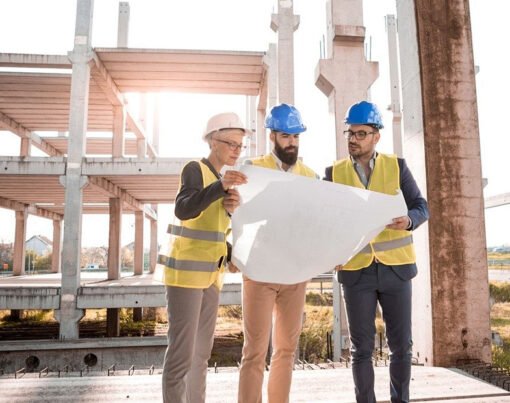Being ahead of the curve is essential for success, as the field of commercial architecture is changing quickly. There are many interesting prospects for future commercial architecture, including creative technologies and sustainable designs. This article explores the major themes influencing the sector in 2024 and provides advice and inspiration for architects, builders, and business owners.
Table of Contents
Sustainable Design
Architects and builders are starting to use eco-friendly ways to create buildings. They often turn to wind or solar power for energy. These sources of energy aren’t new ideas anymore. They’re the current reality! Many office buildings use them, and this helps reduce harm to the Earth. But there’s more than just saving energy at play. A design style known as biophilic architecture is gaining popularity, too. This kind of design not only benefits the planet but also improves the well-being of those who work or visit these spaces. It boosts their happiness and health! So, when you plan to build or renovate a business area, consider this green approach. It’ll not only make your workspace better but also add a feather to your hat for doing the right thing for Mother Earth.
Biophilic Design
The term’ biophilic design’ may be familiar to you; it refers to bringing nature within. This method is changing commercial architecture in 2024. Imagine entering a structure that is adorned with beautiful plants, abundant natural light, and even water elements. These components increase productivity, lessen stress, and enhance air quality in addition to being aesthetically pleasing. Large windows, green roofs, and living walls are examples of biophilic features that designers and architects include in their designs. This is a response to the growing need for healthy work conditions, not just a nod to aesthetics. Companies are learning that employees feel better and perform better when they are in a natural environment.
Smart Technology
In 2024, smart technology will change commercial architecture completely. Picture a building that knows when to change its temperature or lights based on the time of day or if people are inside. This is what the Internet of Things (IoT) does. Nowadays, many modern business places use automated systems and sensors. These technologies help them save energy and make the experience better for users. But there’s more. Virtual reality (VR) and augmented reality (AR) are changing architecture, too. You can see and touch spaces before they get built with these technologies. This makes planning more exact and faster. Automation is also crucial as it simplifies building management and operations.
Modular and Prefabricated Construction
When it comes to modern commercial architecture in 2024, modular and prefabricated construction is gaining momentum. Imagine constructing portions of a project off-site, then putting them together at the final location like enormous LEGO pieces. The speed, effectiveness, and affordability of modular construction are its main advantages. Because prefabricated pieces are produced in regulated settings, they are of the highest caliber and consistency. This method minimizes disturbance to the neighboring surroundings and cuts down on building trash. Furthermore, modular buildings are adaptable; when business needs change, they may be readily enlarged, altered, or even moved. This flexibility makes them an attractive option for various commercial projects, from offices to retail spaces and beyond. Thus, if you’re planning to construct or enlarge a business building, think about the advantages of prefabricated and modular building. It’s a cutting-edge solution that offers quality and speed without sacrificing practicality or design.
Inclusive and Accessible Design
In 2024, commercial architecture will place a greater emphasis on inclusive and accessible design. Imagine a society in which everyone can easily access and use buildings, regardless of age, skill, or background. That’s what inclusive design aims to achieve: making environments that are comfortable and useful for all. To guarantee accessibility, designers and architects include elements like tactile paving, broad doorways, and ramps. However, it goes beyond simply making spaces physically accessible; it also involves designing spaces that accommodate a range of requirements and preferences. This entails making designs that take into account elements like lighting, acoustics, and even cultural sensitivity. The goal is to break down obstacles and encourage equal access and involvement for everyone.
Flexible and Adaptive Design
The newest buzzwords in commercial design for 2024 are adaptation and flexibility. Imagine a location that can readily adapt to your company’s demands, growing one day and changing again the next. That’s what flexible design is all about. Architects, including commercial architects in Colorado and other places, are designing spaces with modular furniture and adaptable layouts to accommodate changing requirements. With this strategy, companies can effectively utilize their space without having to undertake significant modifications or interruptions. However, it goes beyond simply being physically flexible; it also involves planning for a variety of uses. With a few easy changes, a conference room today may become a shared workspace tomorrow. Because of their adaptability to changing work habits, company models, and technological advancements, commercial spaces are certain to stay relevant and functional over time.
Conclusion
In conclusion, innovation, sustainability, and adaptation will define commercial architecture in 2024. To adapt to the changing demands of communities and businesses, the industry is transitioning from embracing biophilic design and smart technology to placing a high value on flexibility and inclusivity. As long as architects and designers keep pushing the envelope and exploring new possibilities, there is countless potential for creating environments that have an impact and are important.










